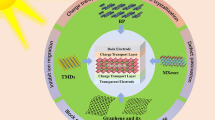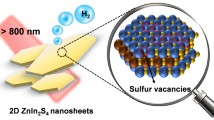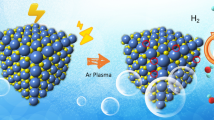Abstract
Two-dimensional van der Waals heterostructures have been widely designed and applied to numerous optoelectronic devices such as photoelectrochemical (PEC)-type photodetectors, water splitting, and solar cells. The understanding of the influence of band alignment in type-I heterostructures on the photoelectric response remains incomplete yet essential for designing new optoelectronic devices. Herein, two-step physical vapor deposition is used to construct a type-I SnSe2/ZnS heterostructure, which is confirmed by ultraviolet photoelectron spectroscopy and X-ray photoelectron spectroscopy. The type-I heterostructure-based PEC-type photodetector exhibits excellent photoresponse, high stability, and high sensitivity in the ultraviolet-visible range. Furthermore, the photoresponsivity of SnSe2/ZnS is up to 172.60 µA W−1, which is 7.4- and 2.0-fold larger than that of pure ZnS and SnSe2, respectively. Moreover, the SnSe2/ZnS heterostructure possesses high photoelectrocatalytic activity in water splitting, and the total hydrogen production within 2 h is up to 81.25 µmol cm−2. The high PEC-type photodetector and water splitting performances in SnSe2/ZnS are due to the synergistic effect of high light utilization and efficient charge transport. Our work provides a new method for improving photoelectric response by forming type-I heterostructures and for designing high-performance optoelectronic devices for photodetectors and water splitting.

摘要
二维范德瓦尔斯异质结构广泛应用于光电化学(PEC)型光电探 测器、水分解和太阳能电池等光电器件中. 其中, I型异质结构对于设 计新型光电器件至关重要, 然而其能带排列对光电响应的影响尚不清 楚. 本文利用两步物理气相沉积法构建了I型SnSe2/ZnS异质结构, 并通 过紫外光电子能谱和X射线光电子能谱进行了验证. 基于I型SnSe2/ZnS 异质结构的光电化学探测器在紫外可见范围内具有良好的光响应、高 稳定性和高灵敏度. SnSe2/ZnS的光响应可达172.60 μA W−1, 分别是单 一ZnS和SnSe2样品的7.4和2.0倍. 并且, SnSe2/ZnS异质结构具有较高的 光电催化分解水活性, 在2 h内总产氢量可达81.25 μmol cm−2. SnSe2/ZnS异质结优异的光电探测和水分解性能主要源于其更高的光利用率 和高效电荷传输的协同作用. 本工作为通过构建I型异质结构来提高光 电响应并设计高性能光电探测器和水分解等光电器件提供了一种新 方法.
Similar content being viewed by others
References
Ma D, Zhao J, Wang R, et al. Ultrathin GeSe nanosheets: From systematic synthesis to studies of carrier dynamics and applications for a high-performance UV-vis photodetector. ACS Appl Mater Interfaces, 2019, 11: 4278–4287
Gao W, Wu C, Cao M, et al. Thickness tunable SnS nanosheets for photoelectrochemical water splitting. J Alloys Compd, 2016, 688: 668–674
Rai RK, Islam S, Roy A, et al. Morphology controlled synthesis of low bandgap SnSe2 with high photodetectivity. Nanoscale, 2019, 11: 870–877
Guo C, Tian Z, Xiao Y, et al. Field-effect transistors of high-mobility few-layer SnSe2. Appl Phys Lett, 2016, 109: 203104
Inamdar AN, Som NN, Pratap A, et al. Hydrogen evolution and oxygen evolution reactions of pristine and alkali metal doped SnSe2 monolayer. Int J Hydrogen Energy, 2020, 45: 18657–18665
Gonzalez JM, Oleynik II. Layer-dependent properties of SnS2 and SnSe2 two-dimensional materials. Phys Rev B, 2016, 94: 125443
Mu J, Guan S, Teng F, et al. Preparation of high-crystalline 2D SnSe2/FTO photoanode and study on photoelectrochemical performance enhancement mechanism. Ceramics Int, 2020, 46: 18911–18923
Nasir MS, Yang G, Ayub I, et al. Tin diselinide a stable co-catalyst coupled with branched TiO2 fiber and g-C3N4 quantum dots for photocatalytic hydrogen evolution. Appl Catal B-Environ, 2020, 270: 118900
Fang Z, Hao S, Long L, et al. The enhanced photoelectrochemical response of SnSe2 nanosheets. CrystEngComm, 2014, 16: 2404–2410
Pawbake AS, Date A, Jadkar SR, et al. Temperature dependent Raman spectroscopy and sensing behavior of few layer SnSe2 nanosheets. ChemistrySelect, 2016, 1: 5380–5387
Dong S, Wang Z. Improving the catalytic activity for hydrogen evolution of monolayered SnSe2(1−x)S2x by mechanical strain. Beilstein J Nanotechnol, 2018, 9: 1820–1827
Hou W, Yu B, Qi F, et al. Scalable synthesis of graphene-wrapped CoSe2-SnSe2 hollow nanoboxes as a highly efficient and stable electrocatalyst for hydrogen evolution reaction. Electrochim Acta, 2017, 255: 248–255
Liu Y, Weiss NO, Duan X, et al. Van der Waals heterostructures and devices. Nat Rev Mater, 2016, 1: 16042
Lyu J, Pei J, Guo Y, et al. A new opportunity for 2D van der Waals heterostructures: Making steep-slope transistors. Adv Mater, 2020, 32: 1906000
Novoselov KS, Mishchenko A, Carvalho A, et al. 2D materials and van der Waals heterostructures. Science, 2016, 353: 9439
Kobayashi Y, Heide C, Kelardeh HK, et al. Polarization flipping of even-order harmonics in monolayer transition-metal dichalcogenides. Ultrafast Sci, 2021, 2021: 1–9
Chang C, Chen W, Chen Y, et al. Recent progress on two-dimensional materials. Acta Physico Chim Sin, 2021, 37: 2108017
Gbadamasi S, Mohiuddin M, Krishnamurthi V, et al. Interface chemistry of two-dimensional heterostructures—Fundamentals to applications. Chem Soc Rev, 2021, 50: 4684–4729
Fan Y, Wang J, Zhao M. Spontaneous full photocatalytic water splitting on 2D MoSe2/SnSe2 and WSe2/SnSe2 vdW heterostructures. Nanoscale, 2019, 11: 14836–14843
Sun B, Ding YF, He PB, et al. Tuning the band alignment and electronic properties of GaSe/SnX2 (X = S, Se) two-dimensional van der Waals heterojunctions via an electric field. Phys Rev Appl, 2021, 16: 044003
Tan P, Chen X, Wu L, et al. Hierarchical flower-like SnSe2 supported Ag3PO4 nanoparticles: Towards visible light driven photocatalyst with enhanced performance. Appl Catal B-Environ, 2017, 202: 326–334
Wang J, Jia R, Huang Q, et al. Vertical WS2/SnS2 van der Waals heterostructure for tunneling transistors. Sci Rep, 2018, 8: 17755
Tang R, Zhou S, Zhang Z, et al. Engineering nanostructure-interface of photoanode materials toward photoelectrochemical water oxidation. Adv Mater, 2021, 33: 2005389
Zirak M, Zhao M, Moradlou O, et al. Controlled engineering of WS2 nanosheets-CdS nanoparticle heterojunction with enhanced photoelectrochemical activity. Sol Energy Mater Sol Cells, 2015, 141: 260–269
Wang CH, Chen CW, Wei CM, et al. Resonant energy transfer between CdSe/ZnS type I and CdSe/ZnTe type II quantum dots. J Phys Chem C, 2009, 113: 15548–15552
Xi J, Wang H, Zhang B, et al. A type I Bi2S3@ZnS core-shell structured photocatalyst for the selective photoelectrochemical sensing of Cu2+. Anal Methods, 2019, 11: 2605–2610
Rahimzadeh N, Ghodsi FE, Mazloom J. Effects of starting precursor ratio on optoelectrical properties and blue emission of nanostructured C-ZnS thin films prepared by spin coating. J Elec Materi, 2018, 47: 1107–1116
Li X, Yu J, Jaroniec M. Hierarchical photocatalysts. Chem Soc Rev, 2016, 45: 2603–2636
Hu JS, Ren LL, Guo YG, et al. Mass production and high photocatalytic activity of ZnS nanoporous nanoparticles. Angew Chem Int Ed, 2005, 44: 1269–1273
Lu C, Ma J, Si K, et al. Band alignment of WS2/MoS2 photoanodes with efficient photoelectric responses based on mixed van der Waals heterostructures. Phys Status Solidi A, 2019, 216: 1900544
Wang D, Liu X, Fang S, et al. Pt/AlGaN nanoarchitecture: Toward high responsivity, self-powered ultraviolet-sensitive photodetection. Nano Lett, 2021, 21: 120–129
Hao X, Wang Y, Zhou J, et al. Zinc vacancy-promoted photocatalytic activity and photostability of ZnS for efficient visible-light-driven hydrogen evolution. Appl Catal B-Environ, 2018, 221: 302–311
Safari M, Izadi Z, Jalilian J, et al. Metal mono-chalcogenides ZnX and CdX (X = S, Se and Te) monolayers: Chemical bond and optical interband transitions by first principles calculations. Phys Lett A, 2017, 381: 663–670
Zhou X, Gan L, Tian W, et al. Ultrathin SnSe2 flakes grown by chemical vapor deposition for high-performance photodetectors. Adv Mater, 2015, 27: 8035–8041
Wang B, Ma L, Sun C, et al. Solid-state optoelectronic device based on TiO2/SnSe2 core-shell nanocable structure. Opt Mater Express, 2017, 7: 3691–3696
Wang J, Lim YF, Wei Ho G. Carbon-ensemble-manipulated ZnS heterostructures for enhanced photocatalytic H2 evolution. Nanoscale, 2014, 6: 9673–9680
Chen SH, Xiao XY, Li PH, et al. A direct Z-scheme ZnS/Co9S8 heterojunction-based photoelectrochemical sensor for the highly sensitive and selective detection of chlorpyrifos. Environ Sci-Nano, 2020, 7: 753–763
Zhang Z, Shao C, Li X, et al. Hierarchical assembly of ultrathin hexagonal SnS2 nanosheets onto electrospun TiO2 nanofibers: Enhanced photocatalytic activity based on photoinduced interfacial charge transfer. Nanoscale, 2013, 5: 606–618
Luo M, Lu C, Liu Y, et al. Band alignment of type-I SnS2/Bi2Se3 and type-II SnS2/Bi2Te3 van der Waals heterostructures for highly enhanced photoelectric responses. Sci China Mater, 2022, 65: 1000–1011
Si K, Ma J, Lu C, et al. A two-dimensional MoS2/WSe2 van der Waals heterostructure for enhanced photoelectric performance. Appl Surf Sci, 2020, 507: 145082
Xiong J, Li X, Huang J, et al. CN/rGO@BPQDs high-low junctions with stretching spatial charge separation ability for photocatalytic degradation and H2O2 production. Appl Catal B-Environ, 2020, 266: 118602
Wang X, Wang X, Huang J, et al. Interfacial chemical bond and internal electric field modulated Z-scheme Sv-ZnIn2S4/MoSe2 photocatalyst for efficient hydrogen evolution. Nat Commun, 2021, 12: 4112
Kaushik N, Karmakar D, Nipane A, et al. Interfacial n-doping using an ultrathin TiO2 layer for contact resistance reduction in MoS2. ACS Appl Mater Interfaces, 2016, 8: 256–263
Wu CR, Chang XR, Chu TW, et al. Establishment of 2D crystal heterostructures by sulfurization of sequential transition metal depositions: Preparation, characterization, and selective growth. Nano Lett, 2016, 16: 7093–7097
Li C, Guo J, Zhang Y, et al. Facile liquid-phase exfoliated few-layer GeP nanosheets and their optoelectronic device applications. J Mater Chem C, 2020, 8: 5547–5553
Zhou Y, Qiao H, Huang Z, et al. Black phosphorus quantum dots as hole capturers in group-VA monoelemental heterostructures for the application of high-performance flexible photodetectors. ACS Sustain Chem Eng, 2021, 9: 14918–14926
Huang W, Zhang Y, You Q, et al. Enhanced photodetection properties of tellurium@selenium roll-to-roll nanotube heterojunctions. Small, 2019, 15: 1900902
Mayer MT, Du C, Wang D. Hematite/Si nanowire dual-absorber system for photoelectrochemical water splitting at low applied potentials. J Am Chem Soc, 2012, 134: 12406–12409
Huang X, Woo H, Wu P, et al. Simple eco-friendly synthesis of the surfactant free SnS nanocrystal toward the photoelectrochemical cell application. Sci Rep, 2017, 7: 16531
Ren X, Li Z, Huang Z, et al. Environmentally robust black phosphorus nanosheets in solution: Application for self-powered photodetector. Adv Funct Mater, 2017, 27: 1606834
Huang H, Ren X, Li Z, et al. Two-dimensional bismuth nanosheets as prospective photo-detector with tunable optoelectronic performance. Nanotechnology, 2018, 29: 235201
Huang W, Xie Z, Fan T, et al. Black-phosphorus-analogue tin monosulfide: An emerging optoelectronic two-dimensional material for highperformance photodetection with improved stability under ambient/harsh conditions. J Mater Chem C, 2018, 6: 9582–9593
Li Z, Qiao H, Guo Z, et al. High-performance photo-electrochemical photodetector based on liquid-exfoliated few-layered InSe nanosheets with enhanced stability. Adv Funct Mater, 2018, 28: 1705237
Zhang Y, Guo J, Xu Y, et al. Synthesis and optoelectronics of mixed-dimensional Bi/Te binary heterostructures. Nanoscale Horiz, 2020, 5: 847–856
Li J, Jin B, Jiao Z. Rationally embedded zinc oxide nanospheres serving as electron transport channels in bismuth vanadate/zinc oxide heterostructures for improved photoelectrochemical efficiency. J Colloid Interface Sci, 2021, 592: 127–134
Zhang J, Liu S, Yu J, et al. A simple cation exchange approach to Bi-doped ZnS hollow spheres with enhanced UV and visible-light photocatalytic H2-production activity. J Mater Chem, 2011, 21: 14655
Zhong D, Liu W, Tan P, et al. Insights into the synergy effect of anisotropic {001} and {230} facets of BaTiO3 nanocubes sensitized with CdSe quantum dots for photocatalytic water reduction. Appl Catal B-Environ, 2018, 227: 1–12
Lu Q, Hutchings GS, Yu W, et al. Highly porous non-precious bimetallic electrocatalysts for efficient hydrogen evolution. Nat Commun, 2015, 6: 6567
Li X, Hao X, Abudula A, et al. Nanostructured catalysts for electrochemical water splitting: Current state and prospects. J Mater Chem A, 2016, 4: 11973–12000
Zhang JL, Zhang XW, Lei LC. Modification of TiO2 nanotubes arrays by CdS and their photoelectrocatalytic hydrogen generation properties. Sci Bull, 2008, 53: 1929–1932
Acknowledgements
This work was supported by the National Natural Science Foundation of China (12074311).
Author information
Authors and Affiliations
Contributions
Xue X and Lu C performed the experiments and analysis; Luo M, Han T, and Liu Y conducted the characterization and analysis; Ge Y and Dong W designed the experiments; Xu X performed the proofreading; Xue X and Lu C wrote the paper with support from Xu X. All authors contributed to the general discussion.
Corresponding author
Additional information
Conflict of interest
The authors declare that they have no conflicts of interest.
Supplementary information
Experimental details and supporting data are available in the online version of the paper.
Xinyi Xue is currently working toward a master’s degree at the Northwest University, Xi’an, China. Her main research direction is the preparation of 2D materials and their optoelectronic properties.
Chunhui Lu is currently working toward a doctoral degree at the Northwest University, Xi’an, China. His main research direction is the preparation of 2D materials and their optoelectronic properties.
Xinlong Xu received his PhD degree from the Institute of Physics, Chinese Academy of Sciences, China, in 2006. He worked as a research assistant at the National Center for Nanoscience and Technology in China, a postdoctoral scholar at Oxford University in England and Nanyang Technological University in Singapore, and an associate researcher at the Institute of Physics, Chinese Academy of Sciences, respectively, from 2006 to 2012. He joined the Northwest University, Xi’an, China, in 2012, as a professor. His research interests include ultrafast optics and THz physics with metamaterials and 2D materials.
Rights and permissions
About this article
Cite this article
Xue, X., Lu, C., Luo, M. et al. Type-I SnSe2/ZnS heterostructure improving photoelectrochemical photodetection and water splitting. Sci. China Mater. 66, 127–138 (2023). https://doi.org/10.1007/s40843-022-2156-y
Received:
Accepted:
Published:
Issue Date:
DOI: https://doi.org/10.1007/s40843-022-2156-y




